Older JR East Limited Express Trains
A number of 183/185/189 and 485/489 series limited express trains remain in service, as do Joyful Trains (covered on a separate page) based on them. The equipment used in these trains dates from the 1970s (and possibly some of it from the 1960s), but continues to serve in niche roles that aren’t well filled by more modern equipment, or at least don’t justify new equipment. However, trains in Japan rarely serve beyond 40 years, so this equipment is likely to be retired over the next few years.
183 Series
The 183 series of 1,500 volt DC EMU, originally introduced by the Japanese National Railways (JNR) in 1972, remains in use for several services by JR East, and is also used by JR West. On many of these services the 183 is only used for seasonal extra trains, with the normal service being provided by newer stock.
Some 183-series equipment presently carries a paint scheme originally used by JNR. The Azusa service photo on the right below is this livery.
The 183-0 series was produced from 1972 to 1975. Assuming I’m reading the Japanese Wikipedia page correctly (online translators aren’t very good), JR East acquired the entire JNR series 0 stock when JNR was broken up in 1987.
The 183-1000 series, equipped for cold-weather operation, was produced from 1974 to 1982. It is this series, again assuming I’m reading it right, that is now used on the Azusa service. Japanese wikipedia entry for the 183 series appears to suggest that some of the 1000 series was rebuilt into a 1500 series (adding ATC equipment, among other things), and this is what is used.
Note the similarities to the 483/485 series equipment (which is AC/DC, for use on lines having sections that use AC power).
Services:
Azusa (seasonal) - Shinjuku to Matsumoto
Hometown Narita (no info on this)
Kaiji (seasonal) - Shinjuku to Kōfu, in Yamanashi prefecture
Wing (unclear if this still exists, possibly replaced by the Narita Express)
Moonlight Nagara - overnight rapid service (operated seasonally as of 2009) from Tōkyō to Ogaki
Moonlight Shinshū (seasonal) - Shinjuku to Matsumoto and Hakuma (rapid service, not limited express)
Shinjuku Sazanami - Shinjuku to Tateyama
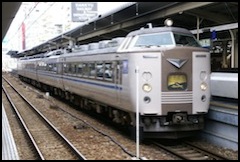
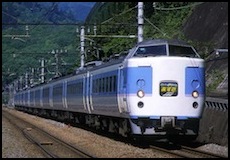
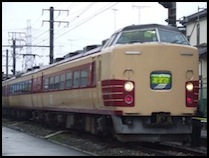
JR West Kitakinki 183 (2007), JR East Azusa 183-1000 (2001), and JR East Azusa 183 (2006)
Photographers: D A J Fossett, DD51612, and Lover of Romance
185 Series
The 185 series of DC EMU, with a top speed of 110 kph, was introduced in 1981 for use in middle-distance limited express service, replacing earlier 153 and 165-series equipment. This equipment is also used in local service out of Tōkyō.
Wikipedia seems to suggest that the 185-200 cold-weather version used out of Ueno has had some sets transferred for use on services out of Tōkyō and Shinjuku. It’s unclear (at least to me) if that means both models are in use on some routes, or if the 185-200 replaced the 185-0.
185-0: used west of Tōkyō along the Izu peninsula
Odoriko - Tōkyō to Izukyū-Shimoda and Tōkyō to Shuzenji
“Liner” service, including Shōnan Liner
185-200: a “cold weather” version used northwest of Tōkyō, over Usui Pass, services include:
Akagi and Weekend Akagi - Ueno Station northwest to Shin-Maebashi Station.
Kusatsu - Ueno to Manzakawaguchi
Minakami - Ueno to Minakami
Ohayō Tochigi - Shinjuku to Kuroiso/Utsunomiya
Hometown Tochigi - Shinjuku to Kuroiso
Odoriko - Tōkyō to Izukyū-Shimoda and Tōkyō to Shuzenji
Hamakaiji - Yokohama to Matsumoto
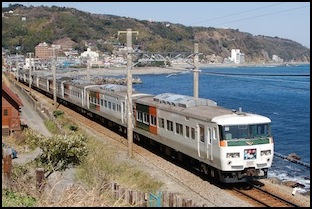
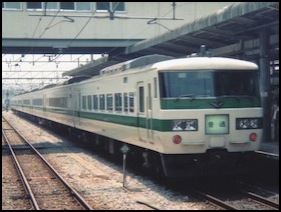
185 in Odoriko service (2007), and 185-200 at Takasaki (1991)
Photographers: Sui-Setz, and Cassiopeia_sweet
189 Series
The 189 series of DC EMU, is not well documented online. It appears to be similar to, but distinct from, the 183 series. Like the 489 (see below) it appears to have been a variant, produced from 1975 to 1979, for use over the steeply graded Usui pass (likely equipped for multiple unit operation, although the 189 entry doesn’t say that the way the 489 entry does).
Prior to the Asama service being taken over by the Nagano Shinkansen, the 189 was used for that limited express service (through 1997).
Services:
Azusa (seasonal) - Shinjuku to Matsumoto
Kaiji (seasonal) - Shinjuku to Kōfu, in Yamanashi prefecture
Shinjuku Sazanami - Shinjuku to Tateyama
Nikkō/Kinugawa - Service to Kinugawa resort from Shinjuku via JR East and Tobu Railway (see also the descriptio of the Ayano Joyful Train)
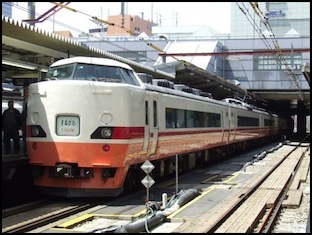
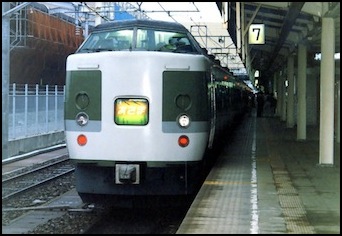
189 in Kinugawa service at Shinjuku Station (2007), and 189 Asama at Nagano Station (1996)
Photographers: Lover of Romance, and Eadeam
It took me a while to figure the Nikkō/Kinugawa out, as the references are mostly in Japanese, and photos were hard to find. The 189 Series pictured on the left is apparently one of two similar trains used for Limited Express duties between Tokyo’s Shinjuku station and two destinations on lines of the Tōbu Railway. The other, and apparently preferred train, is a 485 series, covered in the 485 section below. The visible differences are the headmark panel on the 189 (absent from this particular 485) and the split windshield, which is absent from 3000 series 485’s.
There is a rather cryptic reference on the Japanese Wikipedia page for the 183/189 Series that seems to indicate that the 485 equipment is/was normally used on the Kinugawa service, and the former Ayano 189-based equipment, which isn’t as nicely outfitted, serves as a replacement or peak-period supplement. For more information see the description on the Resort Trains page.
A pair of more recent English-language wikipedia pages describe the Nikkō and Kinugawa as two separate limited express services originating from Shinjuku station in conjunction with the Tōbu Railway. The former runs to Nikkō, where there is an important site with two Shinto shrines and a Buddhist temple, and passengers can also connect with one of the Tōbu Railway’s other lines providing suburban commuter service. The latter runs to the Onsen (hot springs) resort at Kinugawa. Apparently the 189 and 485 versions of the train were used interchangeably on these services, with the 485 the normal train and the 189 serving as backup.
As of 2011, the 485/189 series equipment appears to have been replaced with two sets of the 253-1000 series (former Narita Express equipment), see the 253 description on my JRE Limited Express page.
481/483 Series (and descendants)
Although the 481 came first, the 485 was the most long-lasting version (several are still in use today) and the number is sometimes used as a general term for all three. Also, the principle differences, though not the only differences, were in the motor car and thus the cab and trailer cars may have been re-used from some of the earlier models, and often bear individual car numbers from those series. Finally, the 48x series look much the same as the DC-only 18x series. This can make identifying individual trains difficult.
The following is my current “best guess” without an English-language authoritative source. Mostly it comes from machine-translated Japanese Wikipedia entries, supplemented by information from JR East’s Japanese web pages (again machine-translated) and some N-scale model descriptions.
The Japanese Wikipedia entry for the 485 series clarified this a bit. The 481, introduced in 1963, was dual-voltage, but limited to 60 Hz AC systems as used in western Japan. The 483, introduced in 1964, was dual-voltage, but limited to 50 Hz, as used in Tōkyō and northern Japan. The 485, introduced in 1968, was dual-voltage and dual-frequency. The 489 series (more below) was a variant, introduced in 1972. The 481 and 483 appear to have all been scrapped by 1990 (or at least the motor-cars, or MoHa). Pictures on Wikimedia suggest both 485 and 485-3000 remain in JRE service out of Niigata (on the Sea of Japan coast), and clearly some of the original 481 and 483 cab cars were still in use into the 2000s.
The cab car (KuHa) had several variants. The 481-0 and 481-100 series had a long nose, used for a motor-generator for lighting and a compressor for brakes. This was eliminated with the 481-200 series, which adopted the same flat face used on later designs, although with a number of variations over the years. Note that the circular doors above the white headlights on the 481-200 and later series cabs cover the horns, and swivel open when those are sounded.
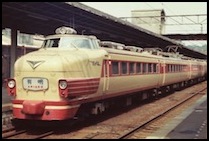
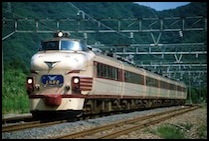
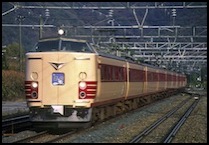
481-0 Series Cab (1980), 481-100 Series Cab (2001), and 481-200 Series Cab (with door) (2002)
Photographers: TK wxrx, Mgamp222, and DD51612
The doors on the 481-200 series cab were problematic, allowing in drafts and contributing to corrosion, and were welded up (becoming essentially invisible) on the 200 cabs in later years, and eliminated on the 481-300 and later cabs.
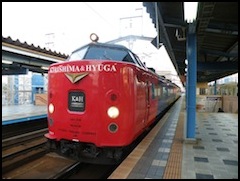
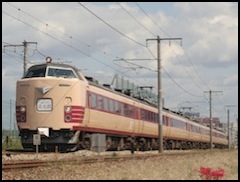
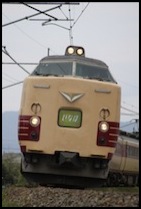
481-200 Series Cab (2009), 481-300 Series Cab (2009), and 481-300 (dual lights, 1500 ser.) (2009)
Photographers: Atasasebo, Mitsuki-2368, and 齋藤雄己
485 Series
The 485 series was introduced in 1968 and operated by several JR companies, including JR East. The train is capable of a top speed of 140 kph. Although these formerly operated out of Ueno Station, and JR East continues to operate them on some services, it would appear that they are no longer operated near Tōkyō on regular services, but see below.
The 485-1500 series (see rightmost photo above) was produced starting in 1974 with cold-weather modifications for use in Hokkaido. As shown above, in at least some cases it used a modified 481-300 cab car design. This didn’t work out (due to a variety of problems, including doors freezing shut), and the equipment was returned to Aomori, and inherited by JR East in 1987 (and apparently transferred to Niigata, on the Sea of Japan coast, in 2000 if I’m reading the Japanese wikipedia page correctly).
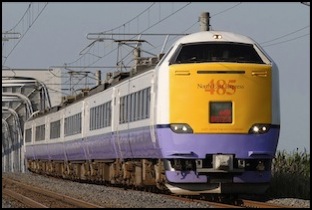
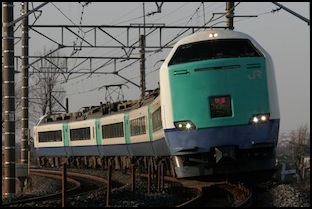
485-3000 (2008), and 485-3000 (2007)
Photographers: View751, and Takuma333777
The 485-3000 is a “refurbished” version of the 485, produced between 1996 and 2001. Note the different arrangement of headlights (both rooftop and lower) on the pictures above. It is used in Inaho, Hokuetsu, and Tsugaru Limited Express service around Niigata, but does not appear to be in use near Tōkyō. However, the 485 Kinugawa train, which serves Shinjuku station in Tōkyō (see below), is a very similar design to the 3000 series. Non-refurbished 485’s are also used in Inaho and Hokuetsu trains.
The 485 series was also used as the basis for a number of similar, but not identical, Joyful Trains (trains used for charter or resort service) based on a modified form of the 485 series. Most of these are variations on a common design, but some are unique. These are described on my Joyful Trains page.
Other Special 485 Trains
JR East operates a 485, similar but not identical to the 485-3000, for its Nikkō-Kinugawa service to the temples of Nikkō and the onsen (hot springs) resorts of Kinugawa, about two hours north of Tōkyō. Trains leave Shinjuku and Ikebukuro stations via the Yamanote Freight Line (apparently) and the Tōhoku Main Line. For more information see the description on the Resort Trains page as well as the 189 section above.
Several different 481/485s have been used for trains to Aizu, a number of them operating out of Tōkyō’s Ueno or Shinjuku stations on weekend and/or holidays in recent years. One of these appears to be similar to a 485-3000 except that it retains the split windshield of the older 481-type cabs. These are also described on the Resort Trains page.
According to one report (thanks, Lindsay), Aizu was served by a 7-car 485-1000 set in the 1990 - 1995 period, operating from Ueno to Aizu Wakamatsu. A similar 9-car set was used for the Ueno - Akita Tsubasa service (which did not stop in Aizu). The Tsubasa was replaced by the Shinkansen of the same name when that began in 1992, but the Aizu service was still operating as of 1995.
JR West also operates a 485 Super Raichō train which has a “panorama” cab car on one end similar to the Yu Resort Express cab (and a “normal” 485 cab on the other end). It does not operate near Tōkyō.
489 Series
As noted above, the 489 series of AC/DC EMU is a variant of the successful 485 series. It was originally a JNR model, introduced in 1972. The train operates on both 1,500 Volt DC and 20,000 Volt AC (at either 50 or 60 Hz, so it can be used in both Western and Eastern/Northern Japan). The train is capable of a top speed of 120 kph.
The 489 was apparently developed for use over the steeply graded Usui pass, and was equipped with multiple-unit connections allowing it to be used in tandem with locomotives such as the EF63.
Wikipedia indicates that JR East continues to operate this equipment, possibly out of Niigata. However, no recent photos in Wikimedia are identified as JR East equipment (all appear to belong to JR West). The photo below is identified as being for Noto service, which Japan Guide’s list of night trains identifies as a non-sleeper Express (not limited Express) service from Ueno (in Tōkyō) to Kanazawa (southwest of Niigata on the Sea of Japan coast), seven hours from Ueno.
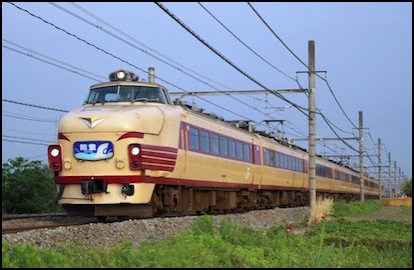
JR West 489 in Noto service (2007)
Photographer: Sui-Setz
The Japanese Wikipedia page on the 485 series contains a substantial amount of information on the 485 and 489 and all the variants, release and scraping dates, etc., far more than I’ve included in this summary.
Additional References
Some of the information provided here came from the Wikipedia articles linked above, while other details were compiled from print and web sources. Among these were:
Taking the Train in Japan, from Japan-Guide.com - A travel website with information about rail travel.
New Technologies for Railway Trains, Hitachi Review (PDF), Vol. 48 (1999), No. 3, pg. 134.
JR East’s list of Joyful Trains (Japanese website).
Japanese Wikipedia page for the Kira Kira Uetsu.
Japanese Wikipedia page for the Oku Vehicle Center.
Japanese Wikipedia page for Tokyo General Rolling Stock Center.




